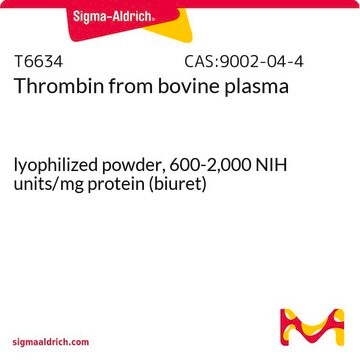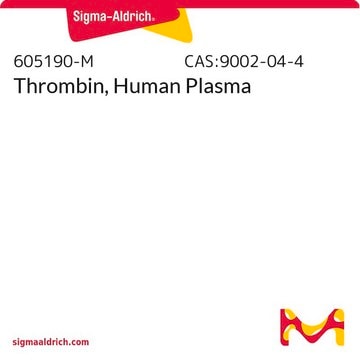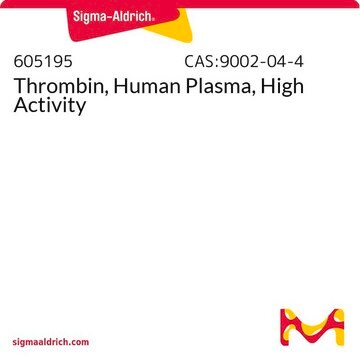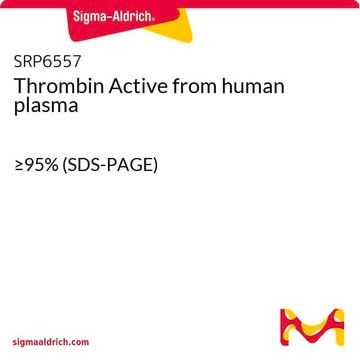This product is a native enzyme from human plasma and does not have a his-tag. Please see the link below to review the product datasheet for additional information: https://www.sigmaaldrich.com/deepweb/assets/sigmaaldrich/product/documents/599/516/t6884pis.pdf
T6884
Thrombin from human plasma
lyophilized powder, ≥2,000 NIH units/mg protein (E1%/280, 18.3)
Synonym(s):
Factor IIa
About This Item
Recommended Products
biological source
human plasma
Quality Level
form
lyophilized powder
specific activity
≥2,000 NIH units/mg protein (E1%/280, 18.3)
mol wt
37.4 kDa
impurities
HIV and HBsAg, source material tested negative
UniProt accession no.
storage temp.
−20°C
Gene Information
human ... F2(2147)
Looking for similar products? Visit Product Comparison Guide
General description
Application
- in the preparation of fibrin gels for assessing human bone marrow stromal cells (hBMSC) morphology[3],
- in the activation of platelets[4],
- to evaluate the integrity of endothelial cell (EC) monolayers[5]
Biochem/physiol Actions
Unit Definition
Physical form
Analysis Note
Other Notes
Disclaimer
inhibitor
Signal Word
Danger
Hazard Statements
Precautionary Statements
Hazard Classifications
Eye Irrit. 2 - Resp. Sens. 1 - Skin Irrit. 2 - STOT SE 3
Target Organs
Respiratory system
Storage Class Code
13 - Non Combustible Solids
WGK
WGK 2
Flash Point(F)
Not applicable
Flash Point(C)
Not applicable
Choose from one of the most recent versions:
Certificates of Analysis (COA)
Don't see the Right Version?
If you require a particular version, you can look up a specific certificate by the Lot or Batch number.
Already Own This Product?
Find documentation for the products that you have recently purchased in the Document Library.
Customers Also Viewed
Articles
Thrombin Factor IIa is an endolytic serine protease that selectively cleaves the Arg--Gly bonds of fibrinogen to form fibrin and release fibrinopeptides A and B.
Thrombin Factor IIa is an endolytic serine protease that selectively cleaves the Arg--Gly bonds of fibrinogen to form fibrin and release fibrinopeptides A and B.
Thrombin Factor IIa is an endolytic serine protease that selectively cleaves the Arg--Gly bonds of fibrinogen to form fibrin and release fibrinopeptides A and B.
Thrombin Factor IIa is an endolytic serine protease that selectively cleaves the Arg--Gly bonds of fibrinogen to form fibrin and release fibrinopeptides A and B.
-
does the thrombin in lotnr T6884 contaning his-tag, which can be removed by Ni affinity column after fusion protein cutting?
1 answer-
Helpful?
-
-
How do I convert 100 units of this thrombin into grams? For a given volume, to determine the concentration, I need to know the exact amount of thrombin in grams which I cannot find anywhere.
1 answer-
The unit per milligram value is reported in the lot-specific Certificate of Analysis. This product has a minimum activity specification of 2000 units per milligram. The amount of powder per vial can be determined by dividing the package size by the unit/mg protein reported on the Certificate of Analysis.
See the link below to review a sample Certificate of Analysis. For this specific lot, the 100UN vial will contain 36.5ug and the 5KU vial will contain 1.83mg.
https://www.sigmaaldrich.com/certificates/sapfs/PROD/sap/certificate_pdfs/COFA/Q14/T6884-100UNSLCP0517.pdfHelpful?
-
-
What expiry should be applied to Thrombin when stored at -70C at 100UN/mL
1 answer-
After reconstitution, thrombin is stable in water for about one week at 0-5°C. If aliquoted in plastic tubes stock solutions are stable for up to 2 months at -70°C.
Helpful?
-
-
Can a stock solution of Product T6884, Thrombin, be stored frozen?
1 answer-
A suggested stock solution is 100 units/ml. The solution should contain 0.1% BSA for stability and may be stable for about one week at 0-5°C. Since thrombin solutions adsorb to glass, it is recommended to aliquot the solutions in plastic tubes and store at -20°C or below.
Helpful?
-
-
What is the Department of Transportation shipping information for this product?
1 answer-
Transportation information can be found in Section 14 of the product's (M)SDS.To access the shipping information for this material, use the link on the product detail page for the product.
Helpful?
-
Active Filters
Our team of scientists has experience in all areas of research including Life Science, Material Science, Chemical Synthesis, Chromatography, Analytical and many others.
Contact Technical Service













